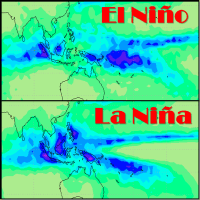




First of all, search the data you seek (no registration required)
* Registration required for download.
Search by:







Physical quantities
precipitation, ocean color, etc.


Spacecraft
spacecraft, sensor, level, etc.


Direct download
How to download via FTP, etc.


Login

User registration

Search this site:




Seasonal and Yearly Variation of Precipitation using the long-term observation of TRMM/PR
October 3 2017 Publish in

TRMM, launched in November 1997, had collected precipitation data for almost 17 years beyond its design life of 3 years. Thanks to the continuous space based observation, the long-term tropical precipitation data is available.
Figure 1 shows the three-month average precipitation during 16 years (1998-2014) using TRMM/PR data. The left map is the period from June to August, and the right map is the period from December to February.
The precipitation data over wide areas including ocean is utilized for these maps. These maps make it possible to see the seasonal variation of global precipitation and heavy monsoon rain.
Additionally, this is a good example that the average of long-term data is utilized for climate analysis too, because TRMM was the long-life satellite.

Figure 1: Three-month Average Precipitation Map for 16 years using TRMM/PR [mm/month]
(Left) June-August (Right) December - February
Figure 2 shows the six-month average precipitation due to El Niño and La Niña based on the long-term TRMM data using the JMA’s definition .
Figure 3 shows the difference between two maps in Figure 2. The convective activity over the ocean and continent is enhanced in the different area between El Niño and La Niña. It indicates the contrast of these precipitation data.

Figure 2: Six-month Average Precipitation Map using TRMM/PR [mm/month]
(Left) During El Niño event (Right)During La Niña

Figure 3: Contrast of maps of Figure 2
Red areas have a large amount of rainfall during El Niño events, and blue areas have a large amount of rainfall during La Niña events.
JAXA provides Case Studies using precipitation data obtained by satellites including TRMM/PR and GPM that is a successor of TRMM, and GSMaP using multi-satellites data. The case studies were written by actual users in Japan and overseas.
Please see below for more information.

Relevant sites:
TRMM Website http://www.eorc.jaxa.jp/TRMM/index_e.htm
Figure 1 shows the three-month average precipitation during 16 years (1998-2014) using TRMM/PR data. The left map is the period from June to August, and the right map is the period from December to February.
The precipitation data over wide areas including ocean is utilized for these maps. These maps make it possible to see the seasonal variation of global precipitation and heavy monsoon rain.
Additionally, this is a good example that the average of long-term data is utilized for climate analysis too, because TRMM was the long-life satellite.

Figure 1: Three-month Average Precipitation Map for 16 years using TRMM/PR [mm/month]
(Left) June-August (Right) December - February
Figure 2 shows the six-month average precipitation due to El Niño and La Niña based on the long-term TRMM data using the JMA’s definition .
Figure 3 shows the difference between two maps in Figure 2. The convective activity over the ocean and continent is enhanced in the different area between El Niño and La Niña. It indicates the contrast of these precipitation data.

Figure 2: Six-month Average Precipitation Map using TRMM/PR [mm/month]
(Left) During El Niño event (Right)During La Niña

Figure 3: Contrast of maps of Figure 2
Red areas have a large amount of rainfall during El Niño events, and blue areas have a large amount of rainfall during La Niña events.
JAXA provides Case Studies using precipitation data obtained by satellites including TRMM/PR and GPM that is a successor of TRMM, and GSMaP using multi-satellites data. The case studies were written by actual users in Japan and overseas.
Please see below for more information.

Relevant sites:
TRMM Website http://www.eorc.jaxa.jp/TRMM/index_e.htm
 Example of use by years
Example of use by years